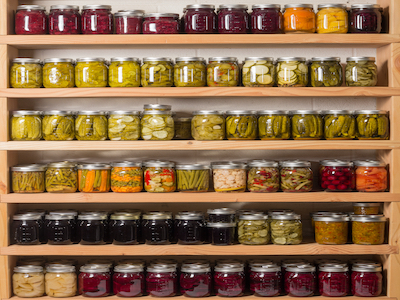Ask an Expert: Seven Tips to Help You Take Stock before Restocking Food Storage

Food Storage
Whether you plan to preserve your garden produce or hit the seasonal case lot sales, take stock of what is still in your freezer, pantry or food storage room.
Family changes, including new additions or downsizing, make taking inventory imperative. Adding 50 quarts of fresh home-canned tomatoes or two more cases of cream of chicken soup to the shelves just because that’s what you’ve always done may not serve you well any more.
Basic guidelines for effective food storage are generally straightforward. Here are seven tips:
- Store only high-quality foods. You may be familiar with the saying, “You get out of something what you put into it.” While this may not be specifically referring to food storage, it is still a true statement. If you preserve bruised or over-ripe produce, don’t expect it to magically turn into high-quality apple pie filling or firm, tender green beans. This is also true of dry goods that may already be old or unclean.
- Practice first in, first out. When stocking your food storage areas, place recently purchased items behind existing food. This will help ensure that food is consumed before spoiling and before the expiration and best-if-used-by dates. If you purchase items in bulk, not all items may be individually dated. Keep a marker close by to include the date.
- Date packaged, frozen meats. Many people raise their own livestock or hunt wild game, and it is not uncommon to have home freezers full of packaged meat. These also need to be dated and rotated to help you avoid freezer burn and tough meat.
- Store what you use, and use what you store. There are those who love to give advice about food storage. Just because it is suggested that powdered milk or honey be part of every family’s emergency or long-term food storage plan, it doesn’t mean you have to do it. If your family prefers canned milk or granulated sugar, go with what you know you will use. Moreover, if you don’t cook with dried beans, for example, perhaps you would be better off storing commercially canned beans.
- Avoid going into debt to purchase food storage. Looking over case lot sales ads can be exciting, but walking into the store with cases of food items strategically placed throughout the store raises the excitement to a whole new level. Before leaving home, make a list, determine how much you will spend, and stick to it. If you plan to buy a half case of canned corn, stick with your plan, even if you have to have an employee divide a box for you.
- Store foods appropriately. It can be very disappointing to take a bag of rice from your pantry shelf only to find it has been nibbled on or has been infested with weevil. Pests feed on or breed in flours, cereals, grains, dried fruit, nuts, candy and other stored foods – if they can get to them. Take time to clean and disinfect the entire area if evidence of pests is found. And to avoid this from happening in the future, as soon as the foods arrive in your home, take time to transfer them into air-tight containers or divide them and place in smaller bags and store them in the freezer.
- Keep food storage areas clean, organized and pest free. If the only space you have to store food is in a garage or storage shed, it will take additional planning to keep your food items safe, clean and not forgotten. It may require you to install insulated cabinets with doors and avoid storing grains in unsealed containers in the same space.
There are a variety of food storage inventory sheets for tracking food that comes in and goes out. Try an internet search for “food storage inventory sheets” and click “images.”
By: Kathleen Riggs, Utah State University Extension family and consumer sciences faculty kathleen.riggs@usu.edu, 435-586-8132


 Utah 4-H & Youth
Utah 4-H & Youth